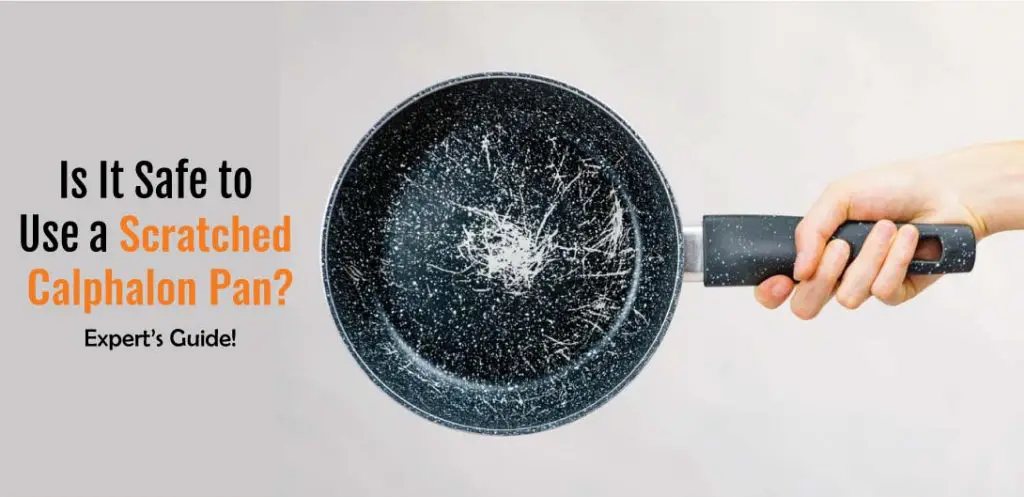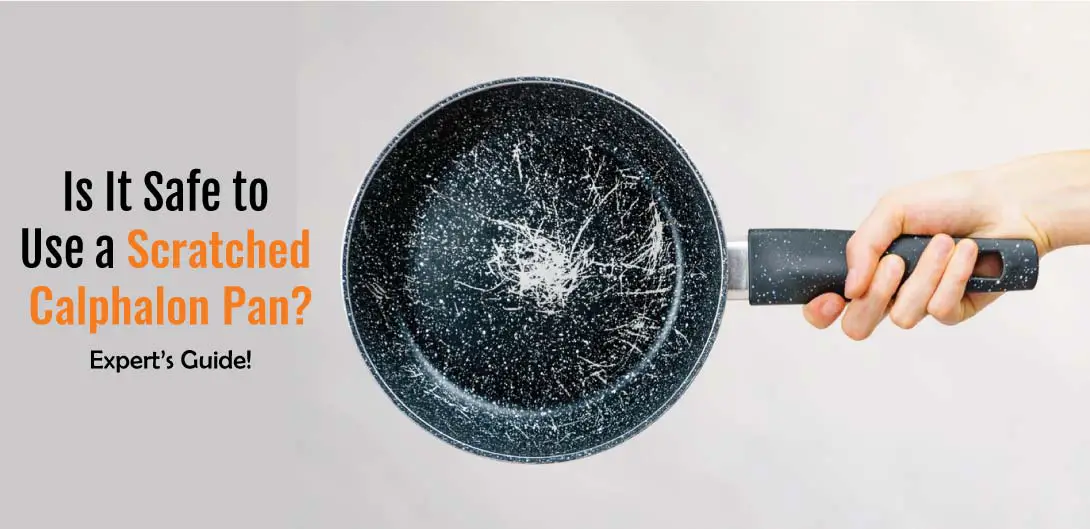Calphalon is a cookware brand founded in the United States known for its unique non-stick surfaces. The Teflon coating is used on the majority of other non-stick cookware.
Calphalon cookware, on the other hand, is made of anodized aluminum. In addition, the cookware’s surface is treated with a “hard-anodizing” technique, which makes it exceptionally resistant to corrosion and scratches. This is why Calphalon pans are regarded as one of the most long-lasting pans in the markets.

Calphalon is safe since it does not release toxins or dangerous compounds into the food. Furthermore, the rigorous anodizing process removes the microscopic holes in the metal that allow food to stick, making the pan incredibly smooth.
With such claims, you must wonder if it is safe to use a scratched Calphalon pan, which we will discuss in this article!
Is Calphalon safe?
All Calphalon non-stick pans manufactured after 2013 are perfectly safe as long as they are not overheated or scratched.
Because of the robust external coating formed during the coating process, the incredibly hard aluminum base is non-reactive and will not seep contaminants into your food. Therefore, it is completely risk-free and poses no threat to one’s health.
Calphalon also uses a non-stick coating on its cooking surfaces to ensure that food does not contact the hard-anodized metal.
Calphalon cookware is safe if the maximum temperature is not exceeded or the surface is not scratched with metal utensils or abrasive cleaning products.
Why is My Calphalon Pan Losing Coating?
To be honest, high temperatures are the recoated pan’s deadliest enemy. This is because high temperatures not only burn the food, but also the coating. As a result, only consider using the pans on the moderate heat option.
When washing the coated pan, make sure you don’t use cold water. This is because cold water can bubble up. As a result, you may use either hot or warm water to clean, and cleaning with hot or warm water will be simpler since the stains will be easier to remove.
Cleaning is an essential aspect of every pot or pan. For example, suppose you’ve recoated the Calphalon pan. In that case, you’ll need to clean it with a soft brush because strong bristles aren’t recommended. Additionally, you can clean with a gentle sponge or a washing cloth.
If you’re worried about the materials, you’ll need to clean the recoated pans; make sure you use the mild cleaning solution. Also, harmful components in the cleaning solutions must be avoided since they might react with the surface and create corrosion.
Is Calphalon Hard Anodized Cookware Safe?
Aluminum is often utilized in the manufacture of cookware because it is plentiful and inexpensive. However, the issue with this substance is that it can leak into your diet and create a variety of significant negative effects. Cookware made of hard-anodized aluminum is an excellent illustration of this.
In high-quality hard anodized cookware, the outstanding properties of aluminum are expected to be kept while keeping it safe for food contact. It’s also said to be more non-stick, making it a healthier alternative for cooking.
Hard anodized aluminum is not reactive, although plain metal is. When the electrolytic passivation is finished, a thick layer of aluminum oxide develops. This layer is inert. This covering protects your food from touch with the simple metal base.
Because hard anodized cookware is non-reactive, you may cook acidic foods like tomato sauce without fear of color or flavor change.
Is it Safe to use a Scratched Calphalon Pan?
Calphalon is safe to scrape. Some people are worried that the coating contains PTFE, similar to Teflon. However, their product lines do have PTFE coatings, which is accurate.
However, if the kitchenware is properly taken care of during use, the PTFE in the coating is entirely safe. It’s non-toxic and doesn’t leak any PTFE as long as you keep it clean.
If you’re concerned about Calphalon cookware being damaged, check for the “Calphalon classic ceramic non-stick set,” launched after 2013.
Is Scratched Anodized Cookware Safe?
In a nutshell, hard-anodized cookware is safe. You must, however, take some care to assure its safety. Plain metal is reactive; however, strongly coated aluminum is not. As a result, a thick coating of inert aluminum oxide accumulates when the electrolytic passivation is finished.
The pigment fills all open holes until they reach the surface, where they are permanently shut. That’s why anodized colors are so long-lasting: they can’t be scratched off the surface since the colors are embedded in the substrate and can only be removed by grinding it away.
Is it Safe to use Scratched Non-Stick Pans?
When the non-stick coating on your cookware is damaged, some of it might flake into your meal (the pan also becomes stickier). Toxic chemicals may be released as a result of this. Cooking with a non-stick pan at high heat is much riskier (this releases a chemical called perfluorooctanoic acid).
Non-stick pans endure around five years with moderate use. To absolutely make sure you are safe, toss out your pan if it is damaged.
Use wooden spoons to stir food instead of steel wool, and avoid stacking your pans to keep them in excellent shape.
FAQs: Related Asked Question
Q1. What to do with old Calphalon pans?
When the non-stick coating on your cookware is damaged, some of it might flake into your meal (the pan also becomes stickier).
Toxic chemicals may be released as a result of this. To be definitely sure you are safe, toss out your pan if it is damaged. Use wooden spoons to stir food instead of steel wool, and avoid stacking your pans to keep them in excellent shape.
Contact a metal scrap yard or a junkyard if the recycling firm won’t take your pans. These businesses specialize in reclaiming metal. The non-stick coating will detach from whatever metal the pan was constructed of once heated. For these professionals, the remaining scrap has worth.
Q2. Are scratched pans carcinogenic?
The problem with Teflon cookware and cancer isn’t because of Teflon. Instead, it has something to do with perfluorooctanoic acid (PFOA), a man-made substance utilized in the Teflon production process.
It’s still worth knowing why PFOA was a source of worry and why it’s no longer used to create Teflon.
PFOA may enter the land, water, and air during manufacture. Therefore, it can last a long period in the environment and your body.
The majority of studies have used extremely high levels of PFOA exposure, with inconsistent findings.
Q3. Are Calphalon pans toxic?
When the non-stick coating on your cookware is damaged, some of it might flake into your meal (the pan also becomes stickier). Toxic chemicals may be released as a result of this. Non-stick pans endure around five years with moderate use. If your pan is damaged, chuck it out just to be safe.
While ceramic cookware is unquestionably safe, we know less about it than we do about other kinds of kitchenware. On the contrary side, Ceramic cookware can endure higher temperatures than non-stick pots and pans made of Teflon. It’s important to remember that objects made completely of ceramic aren’t necessarily ideal.
Conclusion:
Yes, PTFE is used on the surfaces of several Calphalon cookware goods. If the cookware and dishes are properly cared for, therefore, the product is harmless and non-toxic, and no hazardous chemicals are emitted when cooking.
If you’re still concerned, Calphalon has released a new line of ceramic cookware with enameled surfaces, which you can use without worrying about any harmful substance contaminating your food.

